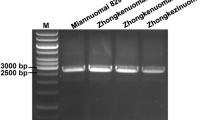Abstract
The caffeic acid O-methyltransferase (COMT) gene plays an important role in the synthesis of lignin. We have used the polymerase chain reaction in conjuction with genomic analysis to characterize deletion mutations of this gene in maize. In addition, we have analyzed and compared regions of the COMT gene from three distinct heterotic groups. Both PCR and Southern analysis indicate that the active wild-type COMT gene can be polymorphic. We suggest that the intron domain of at least one heterotic inbred can contribute to the alteration of the wild-type gene. In addition, multiple deletion mutations have occurred at this locus. We have found a previously uncharacterized deletion mutation in which segments of both the intron and exon have been deleted and replaced by other sequences. Precise knowledge of its sequence has allowed us to develop an assay by which we can follow this mutation in a breeding program.
Similar content being viewed by others
References
Barnes RF, Muller LD, Bauman LF, Colenbrander VF: In vitro dry matter disappearance of brown midrib mutants of maize (Zea mays L.). J Anim Sci 33: 881–884 (1971).
Barriere Y, Argillier O, Chabbert B, Tollier MT, Monties B: Breeding silagemaizewith brown-midrib genes. Feeding value and biochemical characteristics. Agronomie 14: 15–25 (1994).
Boudet AM, Lapierre C, Grima-Pettenati J: Biochemistry and molecular biology of lignification. New Phytol 129: 203–236 (1995).
Cherney JH, Axtell JD, Hassen MM, Anliker KS: Forage quality characterization of a chemically induced brown-midrib mutation in pearl millet. Crop Sci 28: 783–787 (1988).
Cherney JH, Cherny JR, Akin DE, Axell JD: Potential of brown-midrib, lowligninmutants for improving forage quality. Adv Agron 46: 157–198 (1991).
Chiang VL, Funaoka M: The difference between guaiacyl and guaiacyl-syringyl lignins in their responses to kraft delignification. Holzforschung 44: 309–313 (1990).
Dixon RA, Pavia NL: Stress induced phenylpropanoid metabolism. Plant Cell 7: 1085–1097 (1995).
Freudenberg K, Neish AC: Constitution and biosynthesis of lignin. In: Kleinzeller A, Springer GF, Whittmann HG (eds) Molecular Biology, Biochemistry and Biophysics, vol. 2, pp. 1–129. Springer-Verlag, New York (1968).
Higuchi T: Biosynthesis of ligni. In: Higuchi T (ed) Biosynthesis and Biodegradation ofWood Components, pp. 141–161. Academic Press, New York (1985).
Jorgenson, JR: Brownmidrib inmaize and its linkage relations. J Am Soc Agron 23: 549–557 (1931).
Kuc J, Nelson OE: The abnormal lignins produced by the brownmidrib mutants ofmaize. I. The brown midrib-1 mutant. Arch Biochem Biophys 105: 103–113 (1964).
Kuc J, Nelson OE, Flanagan P: Degradation of abnormal lignins in the brown midrib mutants and double mutants of maize. Phytochemistry 7: 1435–1436 (1968).
Kuroda H, Shimada M, Higuchi T: Characterization of a lignin specific O-methyltransferase in aspen wood. Phytochemistry 20: 2635–2639 (1981).
Lewis NG, Yamamoto E: Lignin: Occurrence, biogenesis and biodegredation. Annu Rev Plant Physiol Plant Mol Biol 41: 455–496 (1990).
Murray M, Thompson WF: Rapid isolation of high molecular weight DNA. Nucl Acids Res 8: 4321–4325 (1980).
Porter KS, Axtell JD, Lechtenberg VL, Colenbrander VF: The brown midrib gene (bmr) in sorghum and its affect on forage quality. Proc Int Workshop, Mayaguez P.R, p. 471–482 (1975).
Sambrook J, Fritsch E, Maniatis T: Molecular Cloning: A Laboratory Manual, 2nd ed. Cold Spring Harbor Laboratory, Cold Spring Harbor, NY (1989).
Shimada M, Fushiki H, Higuchi T. Mechanism of biochemical formation of the methoxyl groups in softwood and hardwood lignins. Mokuzai Gakkaishi 19: 13–21 (1973).
Vignols F, Rigau J, Torres MA, Capellades M, Puigdomemech P: The brown-midrib3 (bm3) mutation in maize occurs in the gene encoding caffeic acid O-methyltransferase. Plant Cell 7: 407–416 (1995).
Whettan R, Sederoff R: Lignin biosynthesis. Plant Cell 7: 1001–1013 (1995).
Author information
Authors and Affiliations
Corresponding author
Rights and permissions
About this article
Cite this article
Morrow, S.L., Mascia, P., Self, K. et al. Molecular characterization of a brown midrib3 deletion mutation in maize. Molecular Breeding 3, 351–357 (1997). https://doi.org/10.1023/A:1009606422975
Issue Date:
DOI: https://doi.org/10.1023/A:1009606422975




